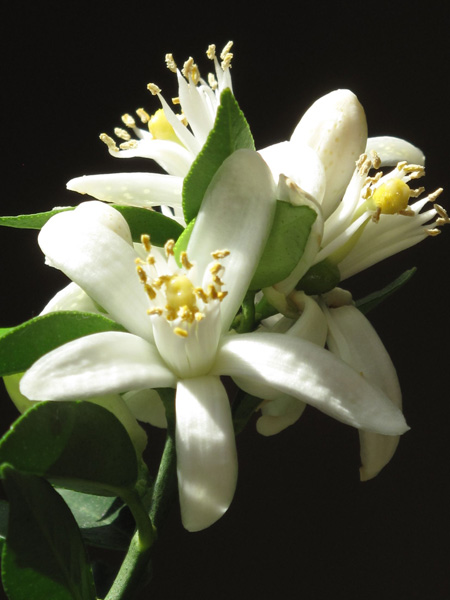Clusters of waxy white orange blossom produce the distinctive and delicious scent that now perfumes the arcades of Cuxa Cloister. The bitter oranges that winter over indoors at The Cloisters are in their second week of bloom. Photograph by Corey Eilhardt
When distilled, the fragrant flowers of the bitter orange yield an essential oil that rises to the top of the vessel. The water that remains once the oil has been drawn off is known as orange flower water. This water has long been used in Middle Eastern cuisines, to perfume sugar syrups used in sweets and pastries, and to flavor beverages.
Distilled waters, also known as hydrosols, have a long history. Orange flower water was in use in Sicily by the fourteenth century as a scent for household linen but was not yet used in cooking. From the sixteenth century on, bitter orange was cultivated in the south of France for the express purpose of producing orange flower water for use both as a perfume and a flavorant, and it was widely used in European cuisine by the seventeenth century. The traditional method of distilling orange blossoms involves the hand-harvesting of fresh, fully expanded flowers. The blossoms are put into a net sack in a copper pot still and covered with about one and a third times as much water. About two pounds of fresh blossoms are required to produce a quart of distillate.
The essential oil distilled from orange blossoms, known as neroli, has been used in perfumery since the sixteenth century and is still an important commodity in the fragrance industry. For a 2007 article on bitter orange and its role in modern perfumery, see “Orange Blossom Week???Part 1: True Renditions” on the Perfume Shrine blog.
The pots of bitter orange (Citrus aurantifolium var. myrtifolia) that spend the winter in the sunny, glassed-in arcades of Cuxa Cloister are now in full bloom and perfume the air. The glass in the cloister will come down in the second week in April, but the orange trees will remain in their sheltered position until the danger of frost is past, when they will be moved out to Bonnefont garden for the summer.
For more on oranges in the Middle Ages, see my recent post “Bitter and Sweet.”
???Deirde Larkin
Sources:
Davidson, Alan. The Oxford Companion to Food. Oxford: Oxford University Press, 1999.
Firth, Grace. Secrets of the Still. McLean,VA: EPM Publications, Inc., 1983.
Tags: bitter orange, Citrus aurantium, distillery, essential oil, fragrance, hydrosol, myrtifolia, neroli, orange blossom, perfume, still


March 18, 2011 at 4:52 pm
[...] divulge all his ingredients. Other formulations from rival makers could include lemon, neroli (from bitter orange flowers), musk, and/or rose [...]
March 22, 2011 at 12:21 pm
Are the Citrus aurantium from Umbria in bloom?
May 7, 2011 at 3:19 am
Citrus sinensis, the sweet orange found in Florida where I live, has very similar blossoms, but I noticed from your photograph that the bloom (and leaves) of the bitter version is thicker and more textured. In addition to citrus scented water, orange blossom honey is a popular by-product here, with a milder taste than other types of honey. For someone who loves both flowers and history, your blog will be a favorite of mine, I’m sure!